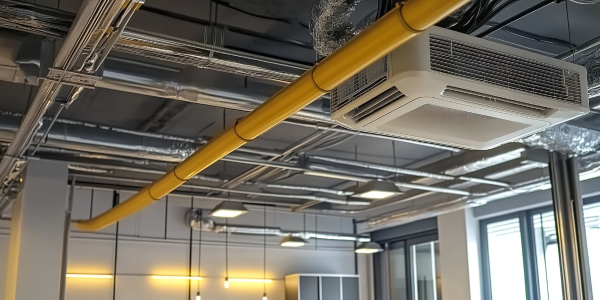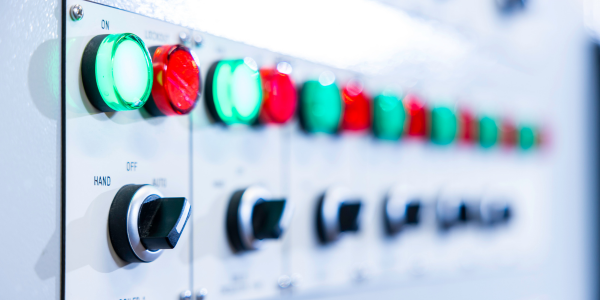Maintaining a comfortable, healthy and energy-efficient environment is essential. For facilities and building managers, choosing the right ventilation system plays a crucial role in achieving the ideal indoor climate. Whether you’re managing a large industrial facility, a commercial space or an office, understanding the four main types of ventilation systems can dramatically impact both air quality and operational costs.
This blog explores the benefits and applications of each ventilation system type, offering insights to help you make the best choice for your building’s needs and energy efficiency goals. In some cases, smart control systems, such as those offered by Cube Controls, can enhance the performance of these ventilation types without needing to replace the full infrastructure.
What Are the Main Types of Ventilation Systems?
Ventilation systems can be broadly classified into four main categories:
- Natural Ventilation Systems – Utilise natural airflow to ventilate a space
- Mechanical Ventilation Systems – Use fans and ductwork to control airflow
- Hybrid Ventilation Systems – A combination of natural and mechanical ventilation for efficiency
- Demand-Controlled Ventilation (DCV) Systems – Adjust airflow based on occupancy and air quality sensors.
Each of these types of ventilation systems has unique advantages, making them suitable for different applications in buildings and industrial settings. Below, we describe each ventilation system type, as well as outlining their advantages and circumstances for use.
Natural Ventilation Systems
Natural ventilation relies on wind pressure and thermal buoyancy to move air in and out of a building. It is commonly found in older buildings as well as modern energy-efficient structures, where the goal is to reduce reliance on mechanical ventilation and lower operating costs. This system uses openings like windows, vents and louvres (i.e. window blinds or shutters with horizontal slats that are angled to admit air) to facilitate airflow without mechanical assistance.
Benefits of Natural Ventilation Systems
The main benefits of natural ventilation systems include:
- Energy efficiency – Reduces reliance on mechanical systems, lowering energy costs.
- Improved air quality – Allows fresh outdoor air to enter, diluting indoor pollutants.
- Low maintenance – No complex machinery means fewer maintenance costs.
- Environmentally friendly – Reduces carbon footprint by using natural airflow.
When to Use Natural Ventilation:
Natural ventilation is most suitable in the following circumstances:
- Buildings with shallow floor plans – If the workspace is not too deep, natural airflow can be effective.
- Low-pollution environments – Suitable for locations with good outdoor air quality, away from busy roads or industrial zones.
- Mild climates – Works well in areas with moderate temperatures where excessive heating or cooling is not required.
- Buildings with operable windows and vents – Structures designed to take advantage of cross-ventilation.
However, natural ventilation is heavily influenced by external weather conditions. It may not be suitable for industrial environments requiring precise airflow control, particularly in spaces with high heat loads or airborne contaminants.
Mechanical Ventilation Systems
Mechanical ventilation uses fans, ducts and other mechanical components to control airflow within a building. These systems are essential in industrial and commercial settings, where controlled ventilation is required to remove airborne contaminants, regulate temperature and maintain consistent air quality, which has a knock on effect on occupancy comfort and therefore productivity by as much as 15%.
Types of Mechanical Ventilation in Buildings
There are four sub-types of mechanical ventilation systems, each designed for specific applications:
- Exhaust Ventilation Systems – Remove stale or contaminated air from enclosed spaces. Commonly used in factories, kitchens and laboratories where pollutants accumulate.
- Supply Ventilation Systems – Introduce fresh air into a building to maintain air quality. Ideal for workplaces in high-pollution areas where external air needs to be filtered before entry.
- Balanced Ventilation Systems – Use both exhaust and supply ventilation to maintain controlled airflow, ensuring a constant exchange of fresh and stale air. Often used in large industrial facilities requiring precise air circulation.
- Local Exhaust Systems – Specifically designed to remove pollutants from particular areas, such as fume hoods in laboratories or dust extractors in industrial manufacturing settings.
Benefits of Mechanical Ventilation Systems
Mechanical ventilation systems offer several key benefits:
- Consistent airflow – Provides stable ventilation regardless of external weather conditions.
- Improved safety – Effectively removes hazardous substances, including dust, fumes and volatile organic compounds (VOCs).
- Customisable control – Can be tailored to meet specific air exchange requirements for different environments.
- Enhances HVAC efficiency – Works alongside heating, ventilation and air conditioning (HVAC) systems to optimise indoor climate conditions. Regular maintenance of HVAC systems ensures these components continue to function at peak performance, preventing issues like energy waste, breakdowns or costly repairs.
When to Use Mechanical Ventilation:
Mechanical ventilation is ideal in the following scenarios:
- Buildings with deep floor plans – Where natural ventilation cannot reach all areas.
- Hazardous work environments – Factories, chemical plants and labs needing consistent contaminant removal.
- High-occupancy spaces – Offices, warehouses or assembly lines where CO₂ levels can rise quickly.
- Extreme weather conditions – Where natural airflow is unreliable due to temperature extremes.
Hybrid Ventilation Systems
Hybrid ventilation, also known as mixed-mode ventilation, combines natural and mechanical ventilation to optimise efficiency and flexibility. These systems automatically switch between natural airflow and mechanical support based on indoor and outdoor conditions.
Benefits of Hybrid Ventilation Systems
The advantages of hybrid ventilation systems include:
- Energy savings – Reduces reliance on mechanical ventilation by utilising natural airflow when conditions allow.
- Improved air quality – Enhances indoor air circulation by maximising natural ventilation when possible.
- Automatic adjustment – Smart sensors regulate airflow based on temperature, humidity and air quality.
- Cost-effective – Reduces overall operational costs by limiting the use of mechanical systems to when they are truly needed.
When to Use Hybrid Ventilation:
Hybrid ventilation is most effective in:
- Buildings with variable occupancy – Schools, office spaces and shopping centres where airflow demands fluctuate.
- Moderate climates – Where both natural and mechanical methods can be alternated seasonally.
- Large commercial spaces – Facilities that benefit from mechanical support during high-occupancy periods but can use natural airflow at other times.
Demand-Controlled Ventilation (DCV) Systems
Demand-controlled ventilation (DCV) systems, often found in smart buildings, utilise sensors to monitor occupancy and air quality, automatically adjusting ventilation rates as needed. This ensures efficient air management while reducing unnecessary energy consumption.
Benefits of Demand-Controlled Ventilation Systems
DCV systems provide numerous benefits, including:
- Optimised energy use – Adjusts airflow dynamically, reducing energy waste.
- Enhanced air quality – Monitors indoor conditions and increases ventilation when pollutant levels rise.
- Customisation – Can be tailored to specific zones or areas within a facility, providing targeted airflow control.
- Reduced operational costs – Lowers energy bills by ensuring ventilation is only used when necessary.
Smart control overlays, like those from Cube Controls, can be retrofitted to existing ventilation systems to make them demand-led, providing advanced efficiency without requiring full system replacement.
When to Use Demand-Controlled Ventilation:
DCV is particularly useful in:
- Workplaces with fluctuating occupancy – Warehouses, meeting rooms and event spaces.
- Buildings with strict energy efficiency targets – Offices and retail spaces aiming to reduce operational costs.
- Sensitive environments – Laboratories, healthcare facilities and clean rooms requiring real-time air quality monitoring.
- Extreme environments like space – Fun fact – on the International Space Station (ISS), where precise airflow is critical, DCV ensures astronauts have optimal air quality by adjusting the ventilation based on sensor data, even in the vacuum of space.
Choosing the Right Ventilation System for Your Needs
Selecting the appropriate ventilation system for your building depends on several key factors, including the building’s design, purpose and environmental conditions. Industrial facilities, for example, require robust solutions to manage air quality, remove contaminants and regulate temperature efficiently. Key considerations include:
- Building Layout & Size – Larger buildings or those with deep floor plans may need mechanical or hybrid ventilation to ensure proper airflow throughout all areas.
- Air Quality Requirements – Workspaces handling chemicals, dust or other pollutants require systems like local exhaust ventilation (LEV) to maintain safe conditions.
- Energy Efficiency Goals – Natural or hybrid ventilation can help reduce energy consumption, while demand-controlled systems optimise airflow based on real-time occupancy and air quality.
- Climate & Location – Natural ventilation is best suited to moderate climates, whereas mechanical ventilation is essential in extreme weather conditions or high-pollution areas.
- Regulatory Compliance – Certain industries must adhere to strict health and safety guidelines, influencing ventilation choices to meet legal requirements.
Assessing these factors will ensure that the selected ventilation system supports both operational efficiency and occupant well-being. Consulting with ventilation specialists can help tailor a solution to meet specific industry and regulatory needs.
Optimising Ventilation for Efficiency and Sustainability
By understanding the strengths and limitations of each of the different types of ventilation systems, building and facilities managers, as well as business owners, can select the most suitable solution for your building’s unique requirements. Whether your priority is energy efficiency, air quality or operational cost reduction, the right ventilation system type will help create a comfortable and sustainable environment. Cube Controls’ building management solutions can help optimise these systems, turning traditional ventilation into smart, demand-responsive infrastructure. Learn more about our HVAC control capabilities here.
Cube Controls is an established and experienced supplier of Building Management Systems, specialising in the design and set up of bespoke environmental and energy control programmes for commercial buildings and property.
To find out how Cube Controls can support you at all stages of design and consultancy, installation and modification and maintenance of your building management systems contact our expert and friendly team on 01903 694279 or sales@cubecontrols.co.uk.




